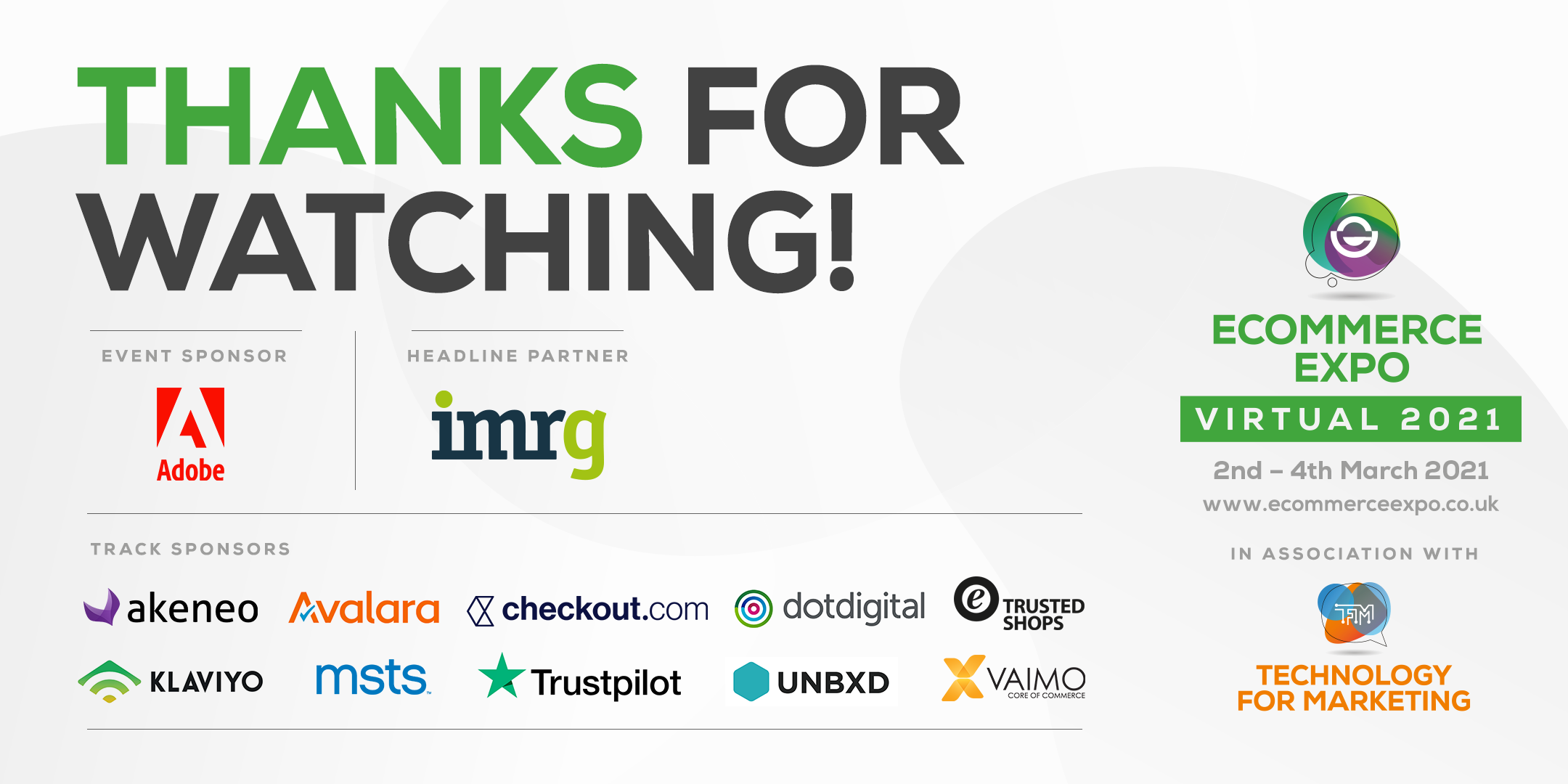eCommerce Expo Virtual 2021
)

The move to digital first has been one of the most significant outcomes of the coronavirus pandemic – working, learning, socialising and shopping have all moved to online formats with non-essential physical spaces closed and restrictions on meeting up.
This year’s eCommerce Expo, which also ran virtually, provided a fascinating insight into how organisations dealt with the period as online selling, virtual communication, and digital brand building came to the fore.
It provided an opportunity to talk trends, with the shift to digital and a change in consumer habits during the worst health crisis in a generation fast-tracking previously nascent areas of commerce and rendering traditional ways of doing business old hat.
The next series of thought pieces pick out the event highlights, underline reimagined digital strategies, and map out a way forward for businesses in need of a post-pandemic vision.
I was happy to chair the Becoming Truly Omnichannel panel discussion on the final day of the three-day event, which gave delegates food for thought in terms of best practice and what is of immediate concern for those in commerce.
Indeed, the whole expo was peppered with valuable information, stories of experiences from big business, and tips and techniques from the technology community – all useful for any individual or organisation operating in this rapidly changing world.
I’d advise anyone to register online to watch the full sessions on catch-up, but you can get a flavour of the event from the reflections below.
I will start with reviewing the tips, tactics and techniques from DTC brands who spoke at eCommerce Expo Virtual '21, such as Only Curls, Rat & Boa, and Ultamodan.

Ben Sillitoe, Editor, journalist and copywriter - Sillitoe Media
D2C the new normal (again!)
Despite its positioning as a modern retail disrupting factor, the concept of direct to consumer (DTC) is not new. But as this year’s eCommerce Expo showed, it has a fresh meaning and is once again in the spotlight as a popular route to generating sales without the need of third-party assistance.
Canadian retail futurist and author, Doug Stephens, aka the Retail Prophet, said recently that he as “always found it curious that DTC is seen as a “new” form of commerce”. In fact, he remarked, “it’s the oldest form of commerce”.
“Third-party, industrialised distribution was the aberration – a devil’s bargain that makers had to agree to, to reach markets at scale,” Stephens added.
Well now, thanks to the advent of online retail – which IMRG estimates grew by 37% year on year in the UK in 2020 – the makers are connecting directly with shoppers again.
But what makes a DTC brand tick?
“We have been lucky this year because we were set up for online business,” explained Lizzie Carter, founder of hair products retailer Only Curls, who said direct engagement with consumers on social media, email and other channels is crucial when launching.
The current digital landscape allows businesses to set up and start selling, sometimes without a completely polished operation, with Only Curls co-founder Hugo Lewis explaining: “Get a product out there and start engaging.”
The D2C model allows for two-way communication, and that is a circumstance womenswear retail Rat & Boa takes advantage of continuously, according to its head of digital, Richard James.
Instagram and email are the “two key pillars” of Rat & Boa’s communications strategy, he said. “By building that relationship directly we have tried to understand our customers through qualitative and quantitative analysis since I joined the business in 2018 and investing marketing budgets in loyalty programmes to reward our fans.”
With the cost of social ads and other paid media spiking in 2020, James focused on maximising revenue from the existing customers. He explained that analysing quantitative statistics such as recency of engagement alongside qualitative data like opinion on product is crucial to tweaking a proposition and keeping shoppers engaged.
“Your next innovation could come from understanding what makes your customers tick,” he advised, talking up the benefits of the D2C channel for staying relevant.
Davina Prasad, director of women’s fashionwear retailer Ultamodan, noted: “Customers want to be able to contact a brand and get a response – people really want a response in 24 hours at least.
“How you engage with your customers is going to help your cost per acquisition, the amount of pounds spent on marketing – it’s key for everything to do with an eCommerce business.”
The new normal (again!)
Heinz in the UK and Ireland and PepsiCo’s US snack brands were standout wholesale businesses that raised their DTC games in the pandemic. They are certainly not about to cut tie with retailers altogether, but both created compelling propositions that show DTC can function as a separate customer-building channel to traditional retail, and others will surely follow as consumers’ comfort with eCommerce remains.
As Carter alluded to, the trend is not going away. She said: “People have got so used to things arriving at their front door and definitely more inclined now to purchase things that they perhaps would not have purchased online before, such as hair products.”
Stay tuned for next weeks' thought piece, which will deep-dive into how Eurostar, Adidas and Love Swap Home are among the businesses discussing personalisation, first-party data and the subscription economy.
Register for on-demand access to view the entire 25+ hours of content, across 8 virtual tracks - register here
Latest News
-
What's wrong with online fashion?
27 Mar 2024 Andy Mulcahy, Strategy and Insight Director, IMRGAs I mentioned in a previous article, eCommerce is going through a tough period at the moment. Following the huge growth online during the lockdowns, it has fallen away consistently as we’ve entered a ... -
ECommerce Talent: Past, Present & Future
27 Mar 2024Discover essential insights into eCommerce talent sourcing trends with Andy Davies, from Vertical Advantage. Learn about salary shifts, leadership gaps, and strategies for sustainable growth. -
Martin Musiol from GenerativeAI.net on Finding Tailored Solutions For Your Business With AI
27 Mar 2024 Laura DazonExplore Martin's journey into AI, and discover his insights on integrating AI into business operations and how can AI enhance creativity. -
The 3 Keys to Success in eCommerce Right Now
27 Mar 2024Learn eCommerce success essentials from Chloë Thomas: adapt, profit, engage. Test and innovate to thrive in today's competitive market. -
Are You Strategising Growth This Year?
04 Mar 2024IMRG’s recent session highlighted key insights for eCommerce growth: 🎧 Listen to the Full Session In This Session: eCommerce Downturn: 2022 saw negative growth in the UK's eCommerce sector, largel ... -
Discover key insights with Paul Walsh, Founder of All Things Amazon.
-
Learn how to go composable with Lampoo, luxury second-hand fashion retailer.
-
A tough, tough start to the year for online retailers
27 Feb 2024 Andy Mulcahy, Strategy and Insight Director, IMRGWith trading conditions proving to be very difficult over the past few years, it was perhaps a surprise that peak trading fell in line with forecasts for online retail. -
Trustpilot's Paul Kirby On Leveraging The Power Of Reviews For Your Business
23 Feb 2024 Laura DazonMeet Paul Kirby, Trustpilot's Enterprise Customer Success Manager, sharing his journey from media advertising to guiding eCommerce leaders through reviews. -
IMRG reveal industry customer acquisition rates, how long customers should be staying with you, and if you’re spending too much to acquire new customers. This session uses IMRG’s unique market dataset ...
-
Manuel Tonz from Bloomreach on Holistic Commerce and Conversational AI
05 Feb 2024 Laura DazonMeet Manuel, the Director of Client Strategy at Bloomreach. -
How to Win the Connected Customer Experience
04 Feb 2024Brands that succeed in 2024 are likely to be those that connect brand and customer experiences seamlessly, digitally and physically in everyday life: at home, in play, in retail, and more. Faced with ... -
A pretty good Christmas for retailers, but… For many retailers selling in the UK market, the past few years have been notable for a clear dip in customer demand; the economic downturn has been reflec ...
-
What does it take to gain 1 million active mobile app users monthly? How do you reach the ability to deploy any applications or API changes worldwide in 5 minutes or less? Well, Formidable’s Director ...
-
Discover the secrets behind Pandora's colossal success as the world's largest jewellery brand in a session titled "How Product Information Management Powers Pandora's Global Retail Growth." The world’ ...
-
Explore the dynamic landscape of Cross-Border eCommerce and its role in unlocking global growth. This expert panel discusses key strategies, technologies, and trends, offering valuable insights for bu ...
-
How to Take An Established Brand to New Markets
22 Jan 2024Moonpig's Director of New Markets & Ventures, Alexander Toft, shared invaluable insights during the conference session on "Taking an established brand to new markets." Here are the key takeaways: Star ... -
The Livestreaming eCommerce market in China is forecast to reach 700bn RMB (£80bn) in 2023, roughly equivalent to the entire eCommerce market of South Korea. Chinese consumers show an increasing appet ...
-
Are you sold on retail media?
10 Jan 2024Discover key insights with experts from Propeller, Boots Media Group, Microsoft and NielsenIQ -
Trustpilot x Henry Case Study: How the Household Brand Boosted its Growth Through Reviews
10 Jan 2024Henry is a fixture in millions of homes in the UK, and part of their success can be attributed to the hyper-focused view on their customers’ experience and loyalty. -
A checklist for improving your key KPIs with Composable commerce while avoiding the most common pitfalls - drawing from practical experience from Lars Petersen, CEO of Uniform, Tomas A. Krag and Malgo ...
-
In today's highly competitive world, where customers have numerous options and heightened expectations, retailers face the challenge of fostering mutually valuable and long-term relationship with thei ...
-
In this session, uncover how Sitecore Commerce breaks away from the one-size-fits-all approach, empowering brands with unique products to maintain their distinctiveness and deliver unmatched customer ...
-
eCommerce Deep-Dive with Andy Mulcahy from IMRG
11 Dec 2023 Andy MulcahyExplore the aftermath of Black Friday 2023 with Andy Mulcahy's analysis. -
Dive into the dynamic world of eCommerce with Chloë Thomas, renowned Author and Podcast Host of eCommerce MasterPlan, as she moderates a panel discussion featuring David Meakin, Head of Partnerships & ...
-
December 2023 in eCommerce
11 Dec 2023Bite-size updates on what happened in eCommerce this month, to keep you ahead of the curve and inform your campaigns. -
Unlock the power of Artificial Intelligence in commerce growth with Shaun McCran, Head of Commerce Product Marketing for Europe at Adobe.
-
In retail, leaders constantly grapple with challenges and opportunities that compel them to reconsider their commerce strategies. This eCommerce Expo Keynote, chaired by Andrew McClelland, hosted Dean ...
-
Michael Scholz, VP of Product and Customer Marketing at commercetools, provides invaluable insights into adopting a composable commerce approach for crafting exceptional shopping experiences. Let's de ...
-
Elevate your customer engagement strategy with Anish Chadda, VP of Product at MessageBird

)
)
)
)
)
)
)
)
)
)
)
)
)
)
)
)
)
)
)
)
)
)
)
)
)
.png/fit-in/500x500/filters:no_upscale())
)
.png/fit-in/500x500/filters:no_upscale())
)
)
)
)
)
)
)
)
.png/fit-in/500x500/filters:no_upscale())
)
)
)
)
